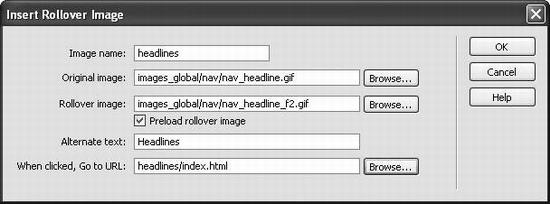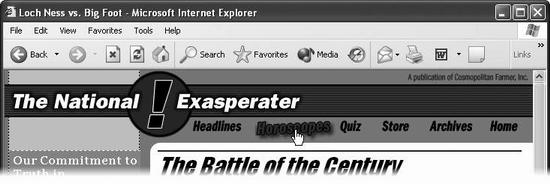5.8 Tutorial: Adding Rollovers
Adding interactive elements to a Web page can be quite a chore. Unless you're a
programmer, learning and using the JavaScript programming language can be timeconsuming
and frustrating. Fortunately, Dreamweaver does most of the work for you,
with its powerful yet easy-to-use Behaviors.
In this tutorial, you'll add rollovers to a page on the National Exasperater Web site.
NOTE
Before you begin, you'll need the tutorial files from
www.sawmac.com/dwmx2004/
. Click the Tutorials
link. Under Images Tutorial, click the Windows or Macintosh link, depending on the kind of machine you're
using, to download the files.
After you've downloaded and decompressed the files, you should have a DWImages folder on your computer,
containing the Web pages and graphics needed for this tutorial. If you're having difficulties, the Web site
contains detailed instructions for downloading the files you'll be using with this book.
In Dreamweaver, choose Site Manage Sites. Manage Sites.
The Manage Sites window opens. Click the New Button and select Site from the pop-up menu.
The Site Definition window opens. In the first tutorial, you used Dreamweaver's
Site Definition wizard (the Basic tab in this window) to get started. You'll use the
Advanced tab this time, so make sure you've selected it. (There's more detail about
the Advanced tab in Chapter 14). In the site name box, type Rollovers.
Dreamweaver will use this name while you're working on this tutorial. Click the folder icon next to the Local Root Folder field, browse to and select the
DWImages folder, and then click Choose. Click OK.
If you see a message that Dreamweaver is about to create a cache for this site,
click OK. Click Done to close the Manage Sites window.
You've now defined the site you'll be working on in this tutorial. Defining Web
sites and using Dreamweaver's site management features are discussed in depth
in Part I. The site's Files window should appear, listing all of the files in the DWImages
folder. (If it doesn't, choose Window Files.) Files.) In the Files window, double-click the file called story.html.
A National Exasperater Web page opens. You'll add rollover images to create a
navigation bar. Click in the empty blue-gray space below the "X" in the National Exasperater
logo.
If you first selected the photo or clicked anywhere inside the main area of the page,
you may see some translucent boxes (marked with numbers like "100% 900")
covering this empty blue-gray area. These boxes are helpful aids for working with
tables (Chapter 7), but they can make it difficult to click inside that space. If you're
having trouble, first select an image (like the logo) near the top of the page. Now
you should be able to clearly see梐nd click梚n the blue area. The insertion point should now be blinking. You've just placed the cursor inside
a table cell where you can add other content such as images or text. Choose Insert Image Objects Image Objects Rollover Image. Rollover Image.
You may prefer to select Rollover image from the Image menu on the Common
tab of the Insert bar (Figure 5-2). Either way, the Insert Rollover Image dialog box
opens (Figure 5-21). In the Image Name field, type Headlines.
In order for this effect to work, each button must have its own name, which the
JavaScript program will use to communicate with and control the graphic. Dreamweaver
gives the graphic a generic name like Image1, but using a more descriptive
name will make it easier for you to edit this effect later on.

Click the first Browse button.
The Original Image dialog box appears. In the next step, you'll select the image
for the button that will appear on the page. Browse to the DWImages images_global images_global nav folder; double-click the graphics
file called nav_headline.gif. nav folder; double-click the graphics
file called nav_headline.gif.
Graphics for just the navigation bar are in a special folder (nav) which is, in turn,
inside the main images folder (images_global). The path to that graphic?span class="docEmphasis">images_
global/nav/nav_headline.gif 梐ppears in the Original Image field. Next stop:
choosing the graphic that will appear when a visitor moves the cursor over the
button.
Click the second Browse button; this time, double-click the file called nav_headline_
f2.gif.
Now, you'll make the button more accessible to people who have turned off their
graphics, or who are using screen-readers to read the page. In the Alternate Text box, type Headlines.
Now all you need to do is add a link to turn the graphic into a navigation button. Click the third Browse button (next to the When Clicked, Go To URL field).
The On Click, Go To URL dialog box opens, awaiting your selection of a Web
page that will open when you click your rollover button. In this case, your button will link to the main page of the "Headlines" section of
the site. Browse to the headlines folder in the DWImages folder, find and double-click
the file index.html.
At this point, the dialog box should look like Figure 5-21
Click OK.
You're back at your Web page document, where your new, rectangular button,
called Headlines, proudly appears. Congratulations! You've made your first rollover. To try it out for yourself, press
F12 to preview the page in your Web browser. When you move your cursor over
the button, the text should turn red and pop out at you. When you click the button,
it should open the "Headlines" page. Return to Dreamweaver.
Do so however you switch programs on your computer梑y using the Windows
taskbar or the Mac OS X Dock, for example. If you like, you can finish up the navigation bar by adding the five other rollover
images. Simply click next to the Headlines button, and then repeat steps 8-16 above.
Here are the names, graphics and pages you should use:
Name: horoscopes
Graphics: nav_horoscopes.gif and nav_horoscopes_f2.gif
Alternate Text: Horoscopes
Page to Link to: horoscopes/index.html
Name: quiz
Graphics: nav_quiz.gif and nav_quiz _f2.gif
Alternate Text: Quiz
Page to Link to: quiz/index.html
Name: store
Graphics: nav_store.gif and nav_store_f2.gif
Alternate Text: Store
Page to Link to: store/index.html
Name: archives
Graphics: nav_archives.gif and nav_archives_f2.gif
Alternate Text: Archives
Page to Link to: archives/index.html
Name: home
Graphics: nav_home.gif and nav_home_f2.gif
Alternate Text: Home
Page to Link to: index.html (the one inside the DWImages folder)
NOTE
If you're curious why all of these pages are named index.html, see the box in Section 14.1.
When you're finished, choose File Save, and then preview your new navigation bar
(Figure 5-22 ) in your Web browser. Move your mouse over the buttons to see if they
change; click to jump to another page. Save, and then preview your new navigation bar
(Figure 5-22 ) in your Web browser. Move your mouse over the buttons to see if they
change; click to jump to another page.
 |
A completed version of this page梟amed finished.html梒an be found in the DWImages folder.
|
|

|
